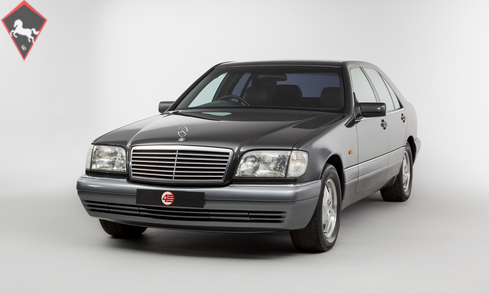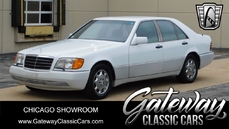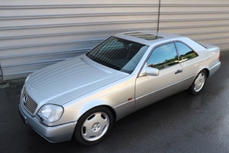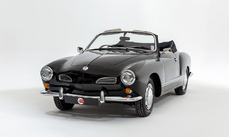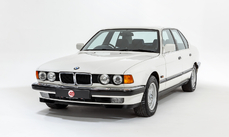Mercedes-Benz w140 S320 1995
General description :
Model History
The Mercedes W140 series made its public debut at the Geneva Motor Show in March 1991, with the first examples rolling off the production line in April 1991. It was the first of the “next generation” of Mercedes-Benz models to feature the company's new design theme. This design was later adopted in 1993 for use on the face-lifted W124, as well as the new C-Class.
As well as a new design, the W140 introduced innovations such as double-pane window glazing, power-assisted closing doors and trunk lid, and electric windows that lowered back down upon encountering an obstruction.
The W140 series is often known as the last Mercedes to be “over-engineered”, a Mercedes trait that was costing the company in product delays and over budgeting. The vehicle is believed to have cost Mercedes-Benz over £500m to develop.
In June 1993, as part of the new corporate naming campaign, the model range was renamed. This resulted in all SE and SEL models now being re-designated as 'S', being followed by the numbering. Mercedes-Benz built 432,732 examples of the W140 series.
Equipment
Blue-Black Metallic paintwork, Black leather upholstery, Electrically-adjustable front seats, Electrically-adjustable steering column, Electric rear window roller blind, 8-hole light alloy wheels, Burred Walnut trim, Double-pane glass, Electrically adjustable door mirrors, Electric windows, Auto-dimming interior mirror, Dual-zone climate control, Soft closing doors, Mercedes cassette radio with CD changer, Spare wheel, Spare key.
Exterior
This handsome W140 S-class is presented in the stylish two-tone paint scheme of Blue-Black Metallic with Alto Grey lower trim – undoubtedly one of the smartest Mercedes colour combinations from this period. The gleaming bodywork remains largely original and in excellent order throughout. On close inspection there are one or two honest marks to be found on the bodywork and bumpers, the worst being a minor graze on the lower rear trim, but overall it’s a fine example indeed. In fact, having spent most of its life in Japan, the car is amazingly free from any of the rust issues commonly found on this era of Mercedes, especially the underside.
VIEWINGS WELCOME BY APPOINTMENT ONLY /// ADDITIONAL PHOTOS AVAILABLE UPON REQUEST
Interior
The S320’s interior space is ample to say the least. Legroom is copious and the seats are notably large and supportive, providing a feeling of luxury and comfort. The leather upholstery still feels soft and supple, and there is no damage or major wear to report. The vast dashboard is free from any unsightly cracks and so is the centre console wood trim – a notorious weak point if over-exposed to sunlight. Furthermore, all of the switchgear is in excellent order and the carpets are kept fresh throughout by a full set of genuine Mercedes overmats, really completing the interior.
ENGINE & TRANSMISSION
Beneath the large bonnet is an orderly engine bay appearing in great shape, free from any signs of damage or poor repair. At the heart of this S-Class is a 3.2-litre straight-six mated to a silken four-speed automatic transmission. The car is wonderfully smooth on test and drives particularly well, but what really sets this one apart is the exceptional rust-free condition of the underside.
Despite its very low mileage of just 34k miles the W140 is accompanied by a great maintenance history. Unlike many Japanese imports this particular example still retains its original maintenance booklet and accompanying service documents from Japan. The last service was done by our trusted classic car specialists at 29k miles; a fresh service and full mechanical inspection will be carried out prior to sale for the new keeper’s peace of mind.
WHEELS, TYRES & BRAKES
The S320 sits on its original 16-inch Mercedes alloys. The wheels retain their factory polished finish and present to a good original standard although a perfectionist may choose to refurb – we have left them unrestored to preserve their originality. They are shod in quality tyres all round with plenty of tread remaining.
History File
This excellent and low mileage W140 S-Class was first registered in August 1995. It resided on the salt-free roads of Japan until 2016 when it was purchased by 4 Star and imported into the UK with all taxes paid on arrival. The car was then fully registered by us before swiftly selling to its new owner. The odometer now reads 55,326km, which equates to a mere 34,377 miles.
Within the History File you’ll find the original Mercedes document pack containing the service booklet, owner’s manual, and Mercedes stereo instructions. Other paperwork includes a raft of underside photos, UK registration documents, MOT certificates, and maintenance invoices from new. Services have been carried out at the following mileages: 1,419 – 1,895 – 9,751 – 15,259 – 16,680 – 17,129 – 17,778 – 19,542 – and lastly at 29,591 miles in August 2018. The car will be freshly serviced prior to sale with a full mechanical inspection carried out also. The advisory-free MOT is valid until October 2020.
http://www.4starclassics.com/for-sale/mercedes-w140-s320-for-sale/
1995 Mercedes-Benz w140 S320 is listed sold on ClassicDigest in Kingsley by 4 Star Classics for £8995.
Car Facts
Car type : Car Make : Mercedes-Benz Model : w140 Model Version : S320 Engine size : 3.2 Model Year : 1995 Location : Hampshire
Sold
Seller Information
Sold
People who viewed this Mercedes-Benz w140 also viewed similar Mercedes-Benz listed at ClassicDigest
Other cars listed for sale by this dealer
About Mercedes-Benz
In the annals of automotive history, the journey of Mercedes-Benz is a tale that unfolds with the ingenuity of its founding pioneers. In the year 1886, Karl Benz crafted the Benz Patent Motorwagen, a creation that would go down in history as the world's inaugural automobile. Unbeknownst to him, this moment marked the genesis of what would evolve into the most illustrious premium car manufacturer globally. The financial underpinning of this pioneering venture, interestingly, was provided by Karl Benz's wife, Bertha Benz, demonstrating a remarkable partnership that would set the tone for Mercedes-Benz's legacy.A parallel narrative emerged not far away, as Daimler-Motoren-Gesellschaft, founded by Gottlieb Daimler and Wilhelm Maybach, entered the scene. In 1901, they unveiled their automobile under the now-famous moniker "Mercedes," meaning "godsend" in Spanish. This name was bestowed upon the car at the behest of Emil Jellinek's daughter, the distributor for Daimler-Motoren-Gesellschaft. The wheels of innovation were set in motion.
Fast forward to 1926, a pivotal year that witnessed the merger of Daimler with Benz & Cie., culminating in the birth of Daimler-Benz. The amalgamation saw the adoption of "Mercedes-Benz" as the distinguished trademark for their automobiles, fusing the legacies of two visionary entities into one.
Contrary to perceptions of conservatism, the trajectory of Daimler-Benz unfolds as a chronicle of industry firsts. From the introduction of the honeycomb radiator to the float carburetor, and the pioneering implementation of four-wheel brakes in 1924, Daimler-Benz consistently pushed the boundaries of automotive innovation. The diesel-powered Mercedes-Benz 260 D in 1936 marked the inception of diesel engines in passenger cars. The iconic Mercedes-Benz 300SL Gullwing made history as the first car with direct fuel injection, albeit the Gutbrod's tiny 2-stroke engine can claim precedence.
Safety innovations became a hallmark, with Béla Barényi's patented safety cell design in the "Ponton"-models in 1951, featuring front and rear crumple zones. The W116 450SEL 6.9 saw the introduction of the Anti-Lock Brake system (ABS), another pioneering safety feature. From the first production airbags and beyond, the legacy of "firsts" continued to be etched into the fabric of Daimler-Benz.
Over its centennial journey, Mercedes-Benz has not merely produced cars but has sculpted automotive icons. The SSKL, 710 SSK Trossi Roadster, 770K Grosser, 540K Spezial Roadster, 300SL Gullwing, w100 600 Pullman, w111 280SE 3.5 Flachkühler, w113 230SL Pagoda, w109 300 SEL 6.3, and w201 2.3-16 Cosworth stand testament to the brand's commitment to engineering excellence.
The roaring Silver Arrows, or "Silberpfeile," including the W 25, W 125, W154, W165, and W196, created a legacy of dominance on the racetrack. These machines were not merely cars; they were expressions of precision, speed, and an indomitable spirit that left their competitors in the dust.
As Mercedes-Benz marches into the future, it does so not just as an automaker but as a custodian of a legacy, a torchbearer of innovation, and a beacon of automotive excellence. The road ahead is sure to witness the continued fusion of cutting-edge technology, timeless design, and an unwavering commitment to setting new standards in the world of automobiles.
One luminary figure who left an indelible mark was Béla Barényi, often heralded as the "father of passive safety" for his pioneering work in safety engineering. His patented safety cell design, featuring front and rear crumple zones, became a hallmark of Mercedes-Benz's commitment to occupant safety, setting new standards that reverberated throughout the automotive world.
Moving through the chronicles, the collaborative genius of Wilhelm Maybach, alongside Gottlieb Daimler, laid the foundation for Daimler-Motoren-Gesellschaft. Their innovations not only birthed the first Mercedes but established a culture of relentless pursuit of technological excellence that remains integral to Mercedes-Benz's DNA.
In the post-merger era of 1926, Ferdinand Porsche emerged as a prominent figure within Mercedes-Benz. His work on the Mercedes-Benz S-Type, a supercharged race car, garnered acclaim and set the stage for a legacy that extended far beyond the marque. Porsche's impact would later extend to his eponymous company, but his influence at Mercedes-Benz during those formative years was pivotal.
As the 20th century progressed, the legendary Rudolf Uhlenhaut emerged as a key figure. Uhlenhaut, an accomplished engineer and the driving force behind the iconic Silver Arrows, played a crucial role in Mercedes-Benz's dominance in motorsports. His engineering prowess and attention to detail were instrumental in creating some of the most formidable racing cars of the era.
In the latter half of the century, figures like Bruno Sacco, the head of design at Mercedes-Benz from 1975 to 1999, left an indelible imprint on the brand's aesthetic identity. Sacco's design philosophy, characterized by clean lines and timeless elegance, shaped iconic models like the W126 S-Class and the W201 190E, solidifying Mercedes-Benz's reputation for luxury and sophistication.
The narrative would be incomplete without acknowledging the contributions of engineers like Hans Scherenberg, whose leadership in the 1970s ushered in a new era of technological innovation at Mercedes-Benz. Scherenberg's tenure saw the development of groundbreaking technologies, including the Anti-Lock Brake system (ABS) and the introduction of airbags in production cars.
